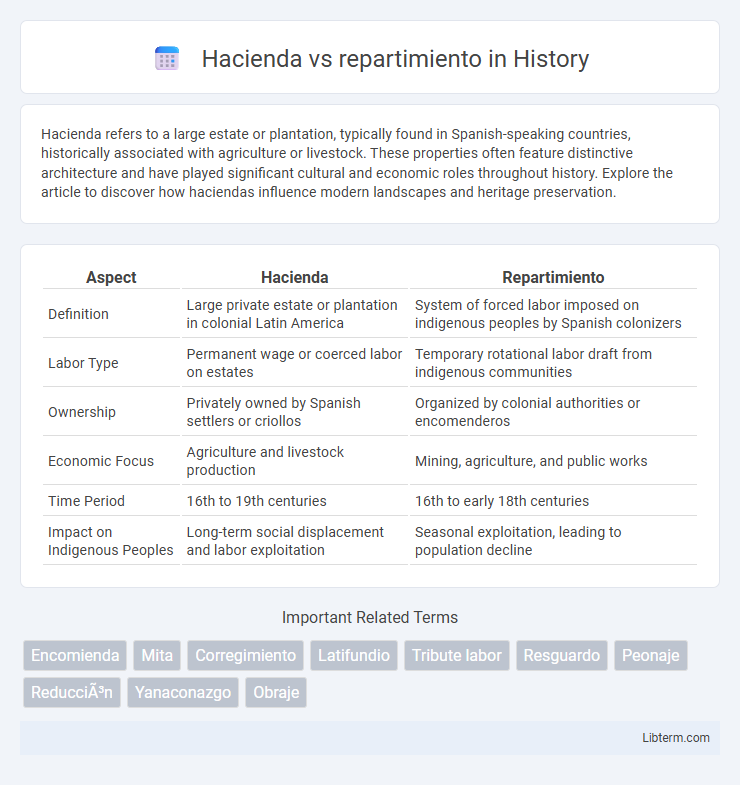Hacienda refers to a large estate or plantation, typically found in Spanish-speaking countries, historically associated with agriculture or livestock. These properties often feature distinctive architecture and have played significant cultural and economic roles throughout history. Explore the article to discover how haciendas influence modern landscapes and heritage preservation.
Table of Comparison
| Aspect | Hacienda | Repartimiento |
|---|---|---|
| Definition | Large private estate or plantation in colonial Latin America | System of forced labor imposed on indigenous peoples by Spanish colonizers |
| Labor Type | Permanent wage or coerced labor on estates | Temporary rotational labor draft from indigenous communities |
| Ownership | Privately owned by Spanish settlers or criollos | Organized by colonial authorities or encomenderos |
| Economic Focus | Agriculture and livestock production | Mining, agriculture, and public works |
| Time Period | 16th to 19th centuries | 16th to early 18th centuries |
| Impact on Indigenous Peoples | Long-term social displacement and labor exploitation | Seasonal exploitation, leading to population decline |
Introduction to Colonial Land Systems
The Hacienda and Repartimiento systems were foundational colonial land management methods in Spanish America, shaping agricultural production and labor organization. Haciendas operated as large estates controlled by Spanish elites, relying on mostly indigenous laborers bound to the land, while Repartimiento was a system of rotational labor drafts imposed on indigenous communities for public and private projects. These systems facilitated colonial resource extraction and social control, significantly impacting indigenous economies and settlement patterns.
Defining Hacienda: Origins and Characteristics
Haciendas originated during the Spanish colonial era as large estates owned by wealthy landowners who controlled agricultural production and local labor, often exploiting indigenous peoples and mestizos. These estates were characterized by self-sufficient economic units with extensive landholdings, diverse crops, and livestock, forming the backbone of rural colonial economies. Unlike the repartimiento, which was a forced labor system imposed by the crown, haciendas functioned as privately managed enterprises centered on profit and social status.
Understanding Repartimiento: Purpose and Processes
Repartimiento was a colonial labor system used primarily in Spanish America, designed to allocate indigenous laborers to Spanish settlers for public projects and agricultural work. Its purpose was to regulate and control native labor while avoiding outright slavery, requiring indigenous men to work a set number of days annually. The system involved rotational labor drafts, ensuring native communities contributed workforce resources without permanent enslavement, but it often resulted in exploitation and harsh conditions.
Historical Context: Spanish Colonial Rule
During Spanish colonial rule, the hacienda system emerged as large landed estates owned by Spanish elites exploiting indigenous labor for agricultural and livestock production. The repartimiento was a forced labor draft compelling indigenous communities to work temporarily on Spanish encomiendas or public projects under strict colonial oversight. Both systems institutionalized economic control and labor exploitation, reinforcing social hierarchies and colonial dominance in Latin America.
Key Differences Between Hacienda and Repartimiento
The Hacienda system involved large-scale land ownership by Spanish elites, where indigenous laborers worked as permanent peasants under a semi-feudal arrangement, while the Repartimiento was a labor draft requiring indigenous communities to provide temporary labor to colonial projects. Haciendas functioned as self-sustaining estates focusing on agriculture or livestock, granting landowners significant economic power, whereas Repartimiento served as a state-controlled labor allocation mechanism with limited labor duration and scope. Key differences include the permanence of labor under Hacienda versus the rotational, often seasonal, labor obligations imposed by the Repartimiento system.
Economic Impact on Indigenous Communities
The hacienda system imposed large-scale, privately-owned estates that extracted wealth through forced indigenous labor and disrupted traditional economies, leading to significant economic displacement and impoverishment of Indigenous communities. Repartimiento, a colonial labor drafting system, coerced Indigenous peoples into temporary labor for state or private enterprises, resulting in widespread exploitation and destabilization of indigenous livelihoods. Both systems facilitated resource extraction favoring colonial elites while undermining Indigenous economic autonomy and perpetuating poverty within native populations.
Social Hierarchies and Labor Relations
Haciendas operated as large privately-owned estates with entrenched social hierarchies where landowners held significant power over indigenous and mestizo laborers, reinforcing a quasi-feudal system. Repartimiento functioned as a colonial labor draft requiring indigenous communities to provide labor for Spanish projects, maintaining exploitative labor relations but allowing limited communal autonomy. Both systems perpetuated social stratification by subordinating indigenous labor to colonial elites, yet haciendas fostered more permanent labor dependency compared to the rotational labor obligations under repartimiento.
Transformation and Decline of Both Systems
Haciendas evolved from encomiendas and thrived as large landed estates relying on peonage and debt servitude, yet faced gradual decline due to agrarian reforms and labor shifts in the late 19th and early 20th centuries. Repartimientos, initially temporary forced labor systems imposed on indigenous populations during Spanish colonial rule, transformed into less coercive forms but eventually collapsed under demographic decline, indigenous resistance, and legal restrictions. Both systems' decline marked the transition towards wage labor economies and modern land tenure structures in Latin America.
Legacy in Modern Latin America
Hacienda and repartimiento systems shaped land ownership and labor relations in modern Latin America, with haciendas establishing large estates controlled by elites, perpetuating social and economic inequality. The repartimiento's forced indigenous labor influenced contemporary labor policies and indigenous rights movements. Both legacies continue to affect rural development, land reform debates, and cultural identity across the region.
Conclusion: Comparing Colonial Institutions
Hacienda and repartimiento represented distinct colonial labor systems with haciendas functioning as large private estates leveraging resident indigenous labor, while repartimientos were rotational labor drafts imposed by the Spanish Crown on native populations. Hacienda estates often led to semi-permanent indigenous servitude and land dependency, whereas repartimientos disrupted local communities through forced labor but were limited in duration. Understanding these differences highlights how colonial institutions shaped socio-economic hierarchies and indigenous experiences in Spanish America.
Hacienda Infographic

 libterm.com
libterm.com